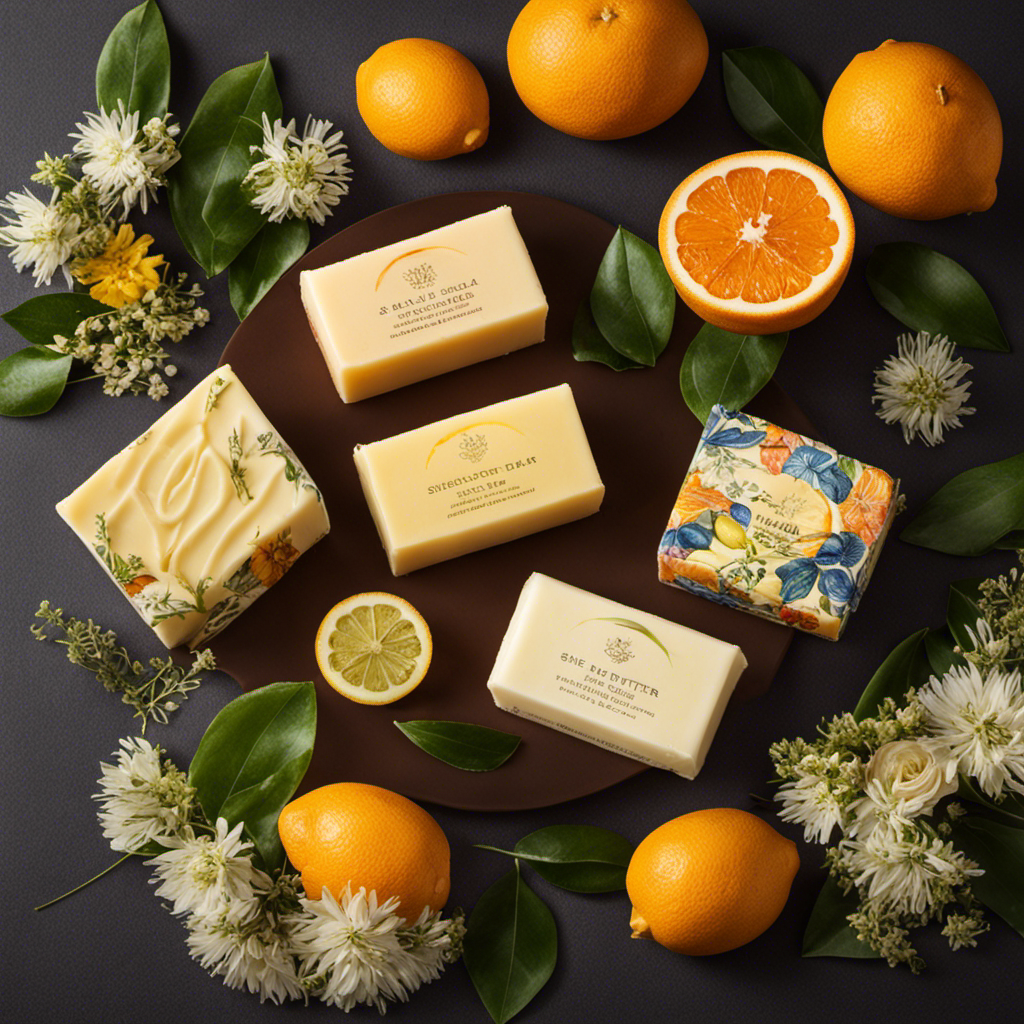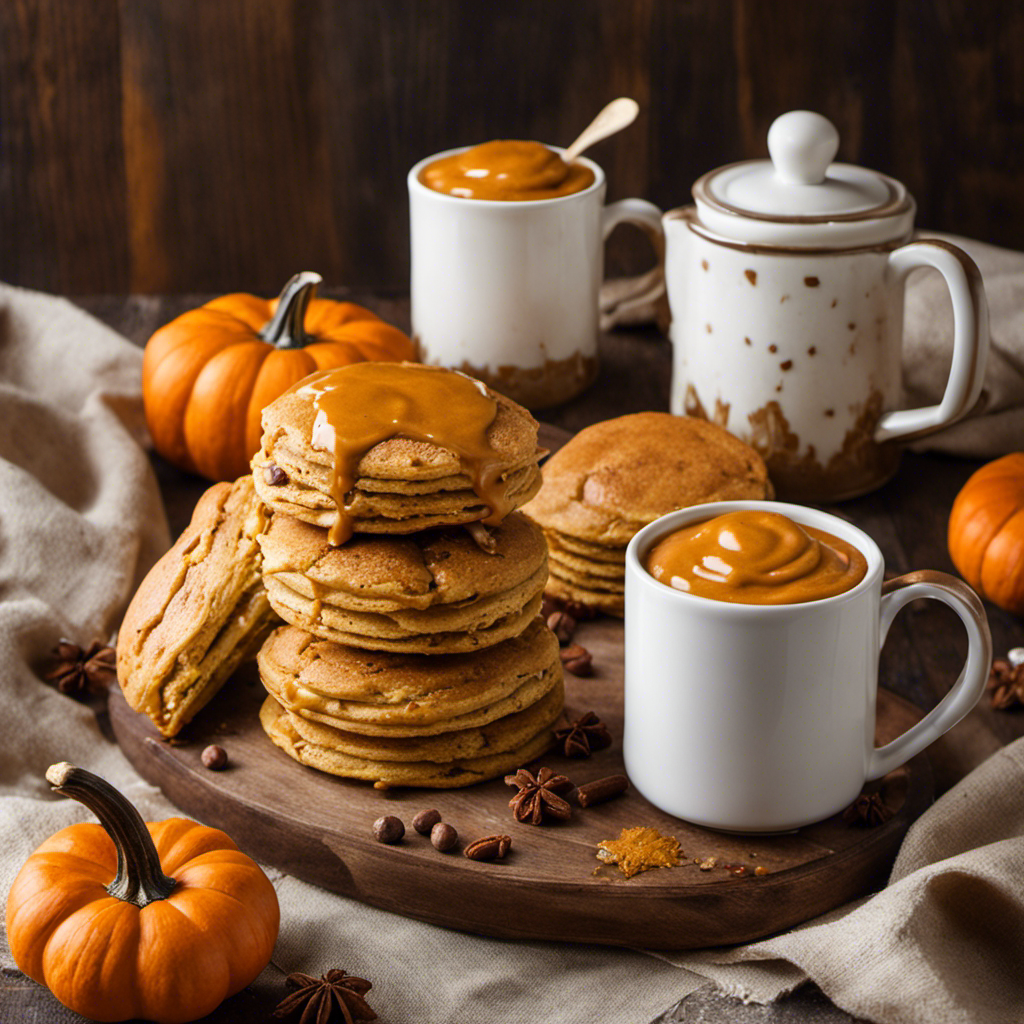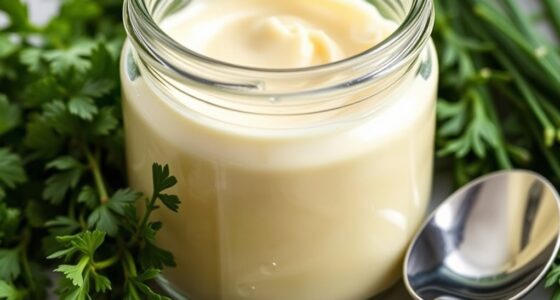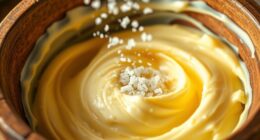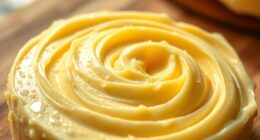Ever thought about how you can give your shea butter a wonderful scent? I have some exclusive tips and tricks just for you.
In this article, I’ll show you the secrets to choosing the perfect fragrance, using essential oils to enhance the scent, and incorporating natural ingredients for that extra touch of freshness.
We’ll also dive into the world of herbs, spices, and floral scents, and even explore the zesty notes of citrus.
So get ready to customize your shea butter scent and elevate your skincare routine to a whole new level of luxuriousness.
Key Takeaways
- Consider the desired scent profile (floral, fruity, woody)
- Use airtight containers to retain the scent
- Essential oil combinations can create a powerful scent
- Experiment with different options to find your desired scent
Choosing the Right Fragrance
To make your shea butter smell good, you’ll need to choose the right fragrance. Customizing the fragrance of your shea butter allows you to create a personalized product that suits your preferences.
When selecting a perfume, it’s important to consider the scent profile you desire. Do you prefer floral, fruity, or woody notes? Take your time to explore different options and find a fragrance that resonates with you.
Choose a perfume that complements the natural scent of shea butter without overpowering it. Keep in mind that a little goes a long way, so start with a small amount and adjust as needed.
Now, let’s move on to the next section where we’ll discuss using essential oils to enhance the scent of your shea butter.
Using Essential Oils
When it comes to using essential oils, there are several key points to consider.
First, the best essential oil combinations can create a powerful and pleasing scent.
Second, the benefits of aromatherapy are numerous, ranging from stress relief to improved sleep.
Lastly, if you’re looking for long-lasting scent options, there are certain oils that are known for their ability to linger throughout the day.
Best Essential Oil Combinations
Using essential oils is a great way to make shea butter smell good. When it comes to blending techniques, there are endless possibilities to create unique and delightful scents. Here are some of the best essential oil combinations to enhance the aroma of your shea butter:
- Lavender and Vanilla: This combination offers a soothing and comforting scent, perfect for relaxation and sleep.
- Citrus Burst: Mix orange, lemon, and grapefruit essential oils for a refreshing and uplifting citrus scent.
- Floral Symphony: Combine rose, jasmine, and ylang-ylang essential oils for a romantic and luxurious floral fragrance.
To ensure scent retention, it is recommended to store the shea butter in airtight containers, away from direct sunlight and heat. Additionally, adding a few drops of essential oils periodically can help maintain the desired fragrance.
Experiment with different blends and enjoy the delightful aromas of your shea butter creations.
Benefits of Aromatherapy
Enhance your well-being and promote relaxation by exploring the numerous benefits of aromatherapy. Aromatherapy utilizes the power of essential oils to improve physical and emotional health. These oils, extracted from various plants, carry potent aromatic compounds that can have a profound effect on our mood and overall well-being. By inhaling these calming scents, such as lavender or chamomile, we can experience reduced stress and anxiety levels, improved sleep quality, and enhanced mental clarity. Aromatherapy can also be used topically, in the form of massage oils or bath salts, to soothe sore muscles and promote physical relaxation. To give you an idea of the variety of scents available, here is a table showcasing some popular essential oils and their corresponding benefits:
| Essential Oil | Benefits |
|---|---|
| Lavender | Calming |
| Peppermint | Energizing |
| Eucalyptus | Respiratory relief |
| Lemon | Mood booster |
| Tea Tree | Antiseptic |
Incorporating aromatherapy into your daily routine can be a simple yet effective way to improve your overall well-being and create a calming atmosphere in your home or workspace.
Long-Lasting Scent Options
There are a variety of long-lasting scent options available in aromatherapy. When it comes to creating a long-lasting perfume or homemade fragrance, it’s important to choose scents that have staying power.
Here are some options to consider:
-
Essential Oils: These concentrated plant extracts are known for their strong and long-lasting scents. Popular choices include lavender, rosemary, and sandalwood.
-
Resins: Resins like frankincense and myrrh have been used for centuries for their aromatic properties. They release a steady, long-lasting fragrance when burned or used in oil blends.
-
Fixatives: These substances help to slow down the evaporation of the fragrance, extending its longevity. Examples of fixatives include benzoin, musk, and ambergris.
Incorporating Natural Ingredients
One way to make shea butter smell good is by adding essential oils.
But if you want to take it up a notch and create a truly unique scent, incorporating fruit extracts and using natural colorants can give your shea butter a delightful aroma.
Fruit extracts, such as mango, strawberry, or lemon, not only add a sweet fragrance but also provide additional benefits for the skin. They are rich in vitamins and antioxidants that nourish and rejuvenate the skin.
Natural colorants like beetroot powder or spirulina can give your shea butter a beautiful and vibrant hue, making it visually appealing.
When combined with essential oils, these natural ingredients create a sensory experience that is both pleasing to the nose and the eyes.
Adding Herbs and Spices
If you’re looking to create a unique aroma, try adding herbs and spices to your shea butter. Not only will this enhance the fragrance of your shea butter, but it will also provide additional benefits for your skin.
Here are three herbs and spices you can use to create a delightful scent:
- Lavender: Known for its calming properties, lavender adds a soothing and floral scent to your shea butter.
- Cinnamon: With its warm and spicy aroma, cinnamon gives your shea butter a cozy and inviting fragrance.
- Rosemary: This herb has a refreshing and herbaceous scent, perfect for revitalizing your shea butter.
Exploring Floral Scents
To explore floral scents, try incorporating dried petals like rose or jasmine into your shea butter mixture. Not only will they add a lovely fragrance, but they will also infuse the butter with their beneficial properties. If you prefer a more intense floral scent, you can also use floral fragrance oils. These oils are concentrated and come in a variety of floral scents, allowing you to customize your shea butter to your liking. Below is a table showcasing some popular floral fragrance oils and their corresponding scents:
| Floral Fragrance Oil | Scent |
|---|---|
| Rose | Sweet |
| Jasmine | Exotic |
| Lavender | Calming |
Experimenting With Citrus Notes
By incorporating dried citrus peels into your mixture, you can infuse your shea butter with a refreshing and zesty scent. Citrus notes add a burst of energy and brightness to any fragrance blend, creating a unique and invigorating experience.
Here are three ways to experiment with citrus notes in your shea butter creations:
-
Lemon: The tangy and vibrant aroma of lemon adds a fresh and uplifting touch to your shea butter. It brings a sense of cleanliness and clarity to the fragrance, making it perfect for a revitalizing body butter.
-
Orange: The sweet and juicy scent of orange creates a warm and comforting aroma in your shea butter. It adds a touch of sweetness and relaxation, making it ideal for a soothing hand lotion.
-
Grapefruit: The zesty and invigorating fragrance of grapefruit adds a burst of energy and vitality to your shea butter. It uplifts the mood and brings a refreshing and rejuvenating feel to your skincare routine.
Experimenting with woody notes like cedarwood or sandalwood can further enhance your fragrance blends, adding depth and complexity to the overall aroma.
Customizing Your Scent
When it comes to customizing your scent, there are a variety of fragrance options available for shea butter. Whether you prefer a floral, fruity, or earthy scent, there is a fragrance oil or essential oil that can enhance the natural scent of shea butter.
Fragrance Options for Shea
You can choose from a variety of fragrance options to make your shea butter smell good. Adding a pleasant scent to your homemade shea butter is a great way to enhance its luxurious feel and make it more enjoyable to use.
Here are some fragrance blending options you can consider:
-
Essential Oils: These concentrated plant extracts are a popular choice for adding fragrance to shea butter. From calming lavender to uplifting citrus, there is a wide range of essential oils to choose from.
-
Fragrance Oils: These synthetic oils are specifically designed for fragrance blending. They come in a wide variety of scents, allowing you to create unique combinations for your shea butter.
-
Natural Extracts: You can also experiment with natural extracts like vanilla or almond to add a subtle, sweet aroma to your shea butter.
Enhancing Natural Shea Scent
Now that we’ve explored various fragrance options for shea butter, let’s delve into enhancing its natural scent.
While shea butter has a mild nutty aroma, some people prefer a more fragrant experience. Luckily, there are natural scent alternatives that can be added to shea butter to enhance its fragrance.
One popular option is adding essential oils. These concentrated plant extracts come in a wide range of scents, from floral and fruity to woody and earthy. Lavender, rose, and vanilla are commonly used to create a soothing and calming aroma. Citrus oils like orange and lemon can lend a refreshing and energizing scent.
Another option is to infuse shea butter with herbs or spices. Dried lavender, chamomile, or rose petals can be mixed into melted shea butter and left to infuse for a few days. This process will impart a subtle natural fragrance.
Remember to start with a small amount of essential oils or herbs and gradually increase until you achieve the desired scent. Experimentation is key to finding the perfect scent combination that suits your preferences.
Frequently Asked Questions
Can Shea Butter Be Used on All Skin Types?
Yes, shea butter can be used on all skin types. However, it is important to consider skin sensitivity and potential allergic reactions. It is best to do a patch test before applying it to larger areas of the body.
How Long Does the Fragrance of Shea Butter Usually Last?
The longevity of the shea butter fragrance can vary depending on factors like the quality of the product and individual body chemistry. However, there are tips for prolonging the scent, such as storing it properly and layering it with other scented products.
Can I Mix Different Essential Oils to Create a Unique Scent for My Shea Butter?
Yes, you can mix different essential oils to create a unique scent for your shea butter. This allows you to customize the fragrance to your liking. Additionally, using shea butter on hair has numerous benefits, such as moisturizing and promoting hair growth.
Are There Any Specific Natural Ingredients That Should Be Avoided When Incorporating Them Into Shea Butter?
When incorporating natural ingredients into shea butter, it’s important to avoid substances that could potentially irritate the skin or alter the texture of the butter. To enhance its fragrance, consider using essential oils or natural extracts.
Can Shea Butter Be Used as a Base for Making Scented Candles or Soaps?
Shea butter can serve as a versatile base for scented candles and soaps. It offers an alternative to traditional wax and provides numerous benefits, such as moisturizing properties and a creamy texture for soap making.
Conclusion
In conclusion, adding a pleasant scent to shea butter is a simple and enjoyable process. By choosing the right fragrance, such as essential oils or natural ingredients, you can create a personalized scent that suits your preferences.
Additionally, incorporating herbs, spices, floral scents, or citrus notes can add depth and complexity to the fragrance. Remember to experiment and customize your scent to truly make your shea butter smell unique.
So go ahead and indulge in the aromatic world of shea butter, and enjoy the benefits of both its nourishing properties and delightful fragrance.
